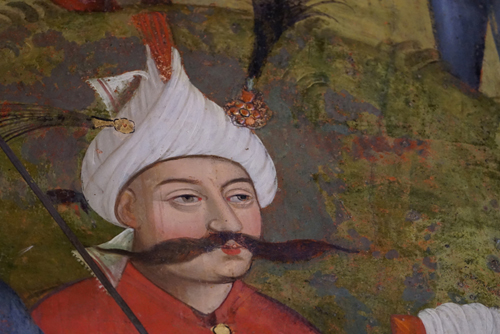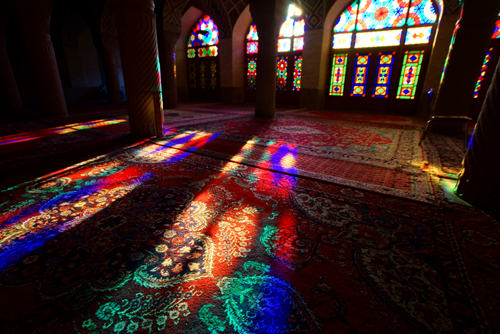It was a 400km drive from Shiraz to Esfahan and on the way we stopped off at Persepolis (City of Persians)
Persepolis was the ceremonial capital of the Achaemenid Empire (ca. 550–330 BC) The earliest remains of the city date from around 515 BC.
It is believed that Cyrus the Great founded the site but it was Darius the Great who constructed the terraces and palaces.
It was built as a ceremonial city to celebrate religious and cultural events. Zoroastrianism was the main religion during this period and the celebration of the New Year was an important event. New Year fell on the first day of Spring, a significant time in an agrarian society.
Over the centuries Persepolis has been mentioned by historians but it wasn’t until 1930 that true scientific research was undertaken. This was carried out by Ernst Herzfeld and Erich Schmidt from the Oriental Institute of the University of Chicago.
It was made a UNESCO World Heritage Site in 1979, immediately following the Islamic Revolution of the same year.
It was sacked by Alexander the Great’s forces in 330 BC, apparently in revenge for the burning of the Acropolis of Athens during the Second Persian invasion by King Xerxes.
We had another side trip, this time to the Naqsh-e Rustam Necropolis.
Built on the road used by the caravans, so that the people could look in awe at the glory of the kings. The oldest part of this necropolis dates back to 1000 BC.
There are four tombs of Achaemenid Kings which are carved out of the rock face. The tombs are in the shape of a cross with the entrance in the centre. Each tomb has similar relief carvings depicting the king and also scenes of battles won and vanquished enemies.
The tombs are believed to be of Darius I the Great (c 522-586 BC), Xerxes I (c. 486-465 BC), Artaxerxes I (c. 465-424 BC), and Darius II (c. 423-404 BC)
The Persian Empire under the Achaemenid Kings, especially Darius the Great, ruled an area covering eight million square kilometres, spread over three continents. At the height of its power it ruled over 44% of the world’s population.
The Achaemenid Empire didn’t just conquer and kill, they introduced structure to the societies they ruled. They built roads, created a common language, developed a postal system and employed a professional army and civil service.
Esfahan is one of the most beautiful cities in Iran.
Its wide tree lined streets are complemented by the winding Zayandeh River that is home to some of the world’s most stunning bridges.
Esfahan also has the expansive and elegant Naqsh-e Jahan Imam Square, which is only second in size to Tiananmen Square in Beijing. The Bazaar-e Layafha circumnavigates the square and is, like all bazaars, a hive of commerce.
The city is the vision of Shah Abbas the Great (1571-1629) who was the inspiration behind much of its outstanding architecture.
The young Abbas came to the throne at 16 but very quickly discovered the art of good politics and shrewd management. He moved the Persian capital from Qazvin to Esfahan and turned it into a showcase of Safavid architecture and style.
Shah Abbas reformed the army and civil service by bringing in many thousands of Armenians, Georgians and others from various parts of the Caucasus. This influx of migration helped to make Esfahan a vibrant multicultural city.
He wasn’t all beauty and light, as late in his rule he had his sons either killed or blinded for fear that they might want to usurp his power.
We visited two of Esfahan’s bridges on a couple of occasions. The first time was when we arrived in the evening, they were illuminated and seemed to float over the water of the Zayandeh River. The second time was late in the afternoon and this time they glowed orange in the setting sun.
Seo-se-Pol Bridge has 33 arches and is 298 meters long. It was and still is also used as a dam. Khaju Bridge is 110 meters in length and was built by Shah Abbas II in 1650. It is one of the finest of the Esfahan bridges and also doubles as a dam.
We were very lucky to arrive in Esfahan when we did, as water had just started to flow again in the Zayandeh River – the first time in three years.
Kakh-e Chehel Sotun or Forty Column Palace was completed in 1649 by Shah Abbas II. It has the nickname of Forty Column Palace, yet there are only 20 columns in the facade. The forty comes from the reflection of the twenty, in the pool at the front.
The interior is radiant with bright, colorful frescos, made even more enjoyable by the abundance of ancient Persians with expansive moustaches.
Rasoul and Hamid had us racing around Esfahan visiting the Masjed-e Shah (Shah Mosque), Masjed-e Sheikh Lotfollah (Sheikh Lotfollah Mosque), Kahk -e Ali Qapu (Ali Qapu Palace or high door) and the Masjed-e Jameh (Jameh Mosque)all within a few hours.
Apart from the excellent Islamic architecture in all of these places, a highlight was the music room in the Kahk -e Ali Quip. Here the walls were adorned with tiles that were complemented by cut-out silhouettes of musical instruments.
While the Shah and Sheikh Lotfollah Mosques had elaborate tiled enterances in a stalactite design.
Amidst our Muslim experiences we also had an infidel moment when we popped into the Church of Saint Joseph of Arimathea, built between 1648 and 1655.
It had an Orthodox Cross on the spire but the interior was more Roman Catholic. We later discovered that this is the style of the Apostolistic Church, found in Armenia.
It’s has been deconsecrated and is now just a tourist attraction.
The interior is richly decorated with original frescos that still maintain their vibrant colours. The exterior is another thing, being very austere and surrounded by a high walls that are a combination of Western and Islamic styles.
An oddity that I found amusing was in the Bazaar-e Layafha. There seems to be an abundance of store mannequins left over from the 1970s. These are in various states of repair but they all have one thing in common. A bizare almost “Nightmare on Elm Street’ ghostliness about their appearance. I found this strange phenonomen in other Iranian bazaars and I haven’t seen it since.
Recently Iran was placed 48 in the top 50 countries visited in 2013-14. This hasn’t happened since the Islamic Revolution in 1979.
It’s good for the travel industry but also creates issues for them in the future.
Iran is still under US and European sanctions. This means tourists can’t use their credit cards and must carry cash for the duration of their trip.
Another problem is the scarcity of good hotels, suitable for Western tastes.
There are plenty of small hotels but not the large ones capable of accommodating big tour groups.
There are a number of other cultural oddities that might put tourists off, but these don’t really don’t matter when you consider the rewarding experience.
As Iran is an Islamic state all ‘women’ over the age of nine, when outside, must wear a hejab to cover their hair and loose fitting clothes, to disguise their figure.
Islam in Iran promotes a society that is male dominated but then again three quarters of the world, if not more, has a obsession with testosterone.
Alcohol is banned in Iran however the locals get around this by brewing, distilling and fermenting their own.
It’s not that easy for visitors to do the same, so just regard your stay as an opportunity to cleanse the liver.
There seems to be a total obsession with Islam and this might worry some people of other faiths. However if you take the emotion out, and view everything in an historical context, it all becomes extremely interesting. Especially when you consider that Judaism, Christianity and Islam have so much in common.
Other peculiarities, that might concern western visitors are the very low doors in the traditional hotels and extremely steep stairways.
Most of our hotel rooms seemed to be on the top floor.
Iranian drivers are regarded as the worst in the world but they are also the most patient.
The rules are, there are no rules, but everyone seems to be accepting of this fact and they just get on with reaching their destination, with as little fuss as possible.
Road Rage doesn’t exist and horns seem to be used to alert other drivers that you are about to do something stupid.
Motorcyclist do more stupid things than anyone else and that’s because they are protected by the law. According to the Iranian traffic laws, if a motorbike and a car are involved in an accident, the motorbike is always in the right.
Why? They are smaller, more vulnerable and need protecting.











